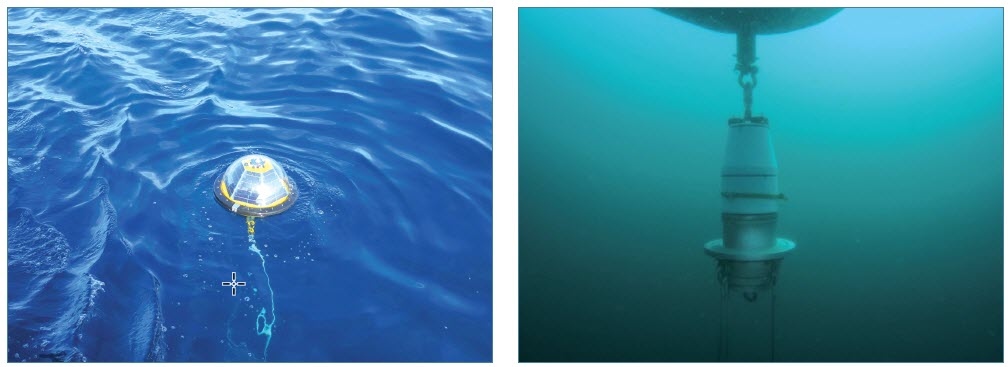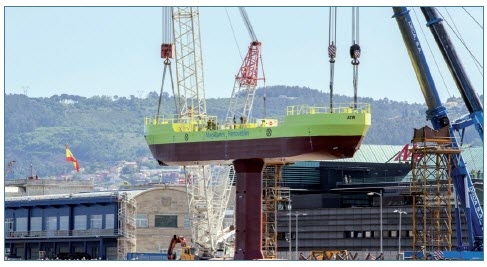SPAIN
TECHNOLOGY DEMONSTRATION
OPEN SEA TEST SITES
BiMEP is an open sea test area located off the coast of Armintza, in the province of Bizkaia. Operating since June 2015, BiMEP offers technology developers an offshore area with suitable wave and wind resources, thereby enabling the demonstration and validation of the technical and economic viability of different concepts of energy converters, equipment and materials prior to commercial development.
BIMEP hosts the first floating wave energy device connected to the grid in Spain (more information about this project in the next section about operational projects). Other test campaigns were carried out at BiMEP in 2017:
- the oceanographic buoy ANTEIA, developed by the company ZUNIBAL, has been tested at BIMEP obtaining very good results to collect, in real time, height, direction and period data, as well as the water temperature;
- DITREL has completed the survivability trials of its electric subsea connector Konekta2 after 6 months installed at BIMEP. Konekta2 can be used to connect and disconnect different types of energy converters in the marine environment.
- IK4-AZTERLAN and TECNALIA also developed some material tests, the former under the OCEANIC project funded by OCEANERA-NET.

ZUNIBAL oceanographic buoy (left) and DITREL subsea connector (right) tested at BIMEP.
Mutriku wave power plant is the first multi-turbine wave energy facility in the world. It is integrated with the breakwater of Mutriku (Basque Country) and based on the OWC (Oscillating Water Column) principle. It has 16 air chambers and 16 sets of “Wells turbines + electrical generator” of 18.5 kW each. The plant was connected to the grid in July 2011. Two of the air chambers are prepared to test OWC components (air turbines, electrical generators, power converters and control systems). During 2017, the Portuguese company Kymaner tested its bi-radial air turbine. This novel turbine was completely designed and manufactured in Portugal, with a total investment value of circa € 1 m, and represents the culmination of the development of a patent originated in IST, protected in several countries interested in wave energy. The turbine prototype has been specifically developed and tested under the EU project OPERA. Mutriku wave power plant has also adapted its premises to better host technology developers during their tests.
PLOCAN, in the Canary Islands, offers a test site for marine energy converters among other uses. It includes an offshore multipurpose platform providing workshops, laboratories, classrooms, training rooms and open working areas around a test tank to facilitate sea trials and launching vehicle to the sea. PLOCAN is developing the Project REDSUB (2017-2019), awarded by the Smart Growth Operational Programme 2014-2020 co-funded by European Regional Development Fund. This project, entitled “Electricity grid to provide support for experimenting and testing new technologies that use marine energy resources to generate electricity and for connecting technologies for observation at increasing depths”, consists of conducting a series of activities that range from the design, acquisition and installation, to the commissioning of a sea-to-shore electricity grid and data network in the area of the maritime-terrestrial public domain reserved for the Ministry of Economy, Industry and Competitiveness. The electrical system to be installed is comprised of medium-voltage wiring and it will be designed, fitted and sized to carry an initial maximum of up to 15 MW to shore. Most of this comprises an underwater cable, connectors and auxiliary electrical equipment (marine electrical system), which will be laid from the area of the PLOCAN reserve at sea to the sectioning and protection centre located on the coast, which will allow electrical protection between the 13.2 KV substation and the devices connected at sea. The transition of the wiring from underwater to terrestrial wiring will be done at this centre, which will connect to a shore-based sub-station to feed the electricity into the distribution grid (terrestrial electricity system). The installation of two submarine cables (5 MW/13,2 kV) started in 2017 and, depending on the weather conditions, is expected to be fully commissioned during the first semester of 2018.
OPERATIONAL PROJECTS
The Mutriku wave power plant has completed six years of continuous operation reaching a record of cumulative energy from waves powered to the grid of almost 1.5 GWh. As mentioned in the previous section, it is also being used as a test site for OWC components.
Following the deployment of the MARMOK-A-5 device in October 2016 by the Basque company Oceantec Energías Marinas and later commissioning work, the first kW was injected into the grid on 13th December 2016. Hence, the wave energy device celebrated in 2017 its first anniversary in the water at BiMEP test site. During this thrilling year, MARMOK-A-5 has demonstrated survivability in winter seas up to 12 m maximum wave height and displayed increasing availability reaching 85% at present. The research team has been able to gain 1,000 h experience in operation and maintenance as well as confidence in its power performance and mooring system robustness. MARMOK-A-5 is prepared for its second winter in a row at BiMEP. In spring 2018, it will be towed in for refitting and integration of the different innovations that have been developed in the OPERA project. Then it will be returned to it mooring site to collect more data for benchmarking. Prototype development has received funding from the Basque Energy Agency under a Pre-Commercial Procurement Contract.

MARMOK-A-5 wave energy device at BIMEP W1 wave energy device at PLOCAN test site in the Canary Islands
UNDIGEN+ Project is a wave energy conversion demonstration project based on the industrial-scale W1 (WEC by Wedge technology), and it is the continuation of UNDIGEN Project, accumulating roughly 4 years, continuously in the Atlantic Ocean, of the W1 wave energy converter. The W1 system configures itself as an axisymmetric resonant point absorber with an innovative direct drive power take-off (linear generator) by applying & validating the continuous R&D activity developed in wave energy (technology development & testing) for more than ten years. The W1 system has been testing at PLOCAN site in the Canary Islands. UNDIGEN+ is a demonstration project partially funded by the Spanish Ministry of Economy and Competitiveness, led by the Spanish tech-company Wedge Global in collaboration with SAES, CIEMAT and PLOCAN which has concluded by the end of 2017.
|
Galicia-based Magallanes Renovables finished its 2 MW floating platform in April 2017 and by the end of summer was moored in the bay of Vigo where Magallanes has started its mooring and towing tests (to simulate sea currents) in order to make the set-up and check all the devices worked properly. After winter time, the platform of Magallanes will be towed to EMEC in Scotland where it will be connected to the grid to start producing electricity. This test will allow the company to validate the technology, study O&M costs and approach the market. |
 Magallanes floating tidal device launching |
PLANNED DEPLOYMENTS
A wave-pumped desalination project is expected to be installed in 2018 at PLOCAN. This project is promoted by the company Tveter Power based on a point absorber wave energy converter. PLOCAN is also expecting to see two offshore wind projects deployed by ESTEYCO (ELICAN project) and ENEROCEAN (WIP10+ project).



